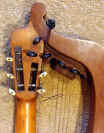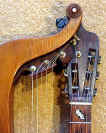 |
 |
 |
 |
|
 |
||||
Knutsen Harp Guitar
Here is another recently discovered 11-course "1898
Patent-style" instrument with the original wood nut. Note how this one is
tapered wider at the top where the strings lie. The bass assembly also
terminates early, putting the 4th tuner directly on the headstock. And another
carved bridge - though the shape is most similar to HGP7, the carving relief is
very similar to the Anderson-built HGP15. The label appears on other guitars,
but here "..ed Sept 15, 1896" is crossed out, with "applied
for" handwritten over it.
The owner, John Roberts, writes,
"From the small amount of fret wear,
I'm guessing it was not played for very long. When I acquired it the bridge was
broken in two with one half hanging loose on the inside of the body. My guess is
that it was never strung up since the bridge broke and that is why it is
relatively intact. I have an instrument repair friend who put the bridge back
together and put in some non-original bridge pins. He also repaired a couple
cracks. Other than that it is all original. I have it strung with steel strings
just for presentation purpose. If you look closely at the picture of the fingerboard you can see it has a seam 3/8" from each side- it was made from three
pieces. Possibly the builder had a leftover piece of rosewood that wasn't wide enough so he glued a narrow strip on each side. A
cabinet maker using up some scraps? The neck is made out of a light colored softwood like spruce or even Alaska yellow cedar, which would have been quite available
in this area. I've read that Martin was using some kind of light colored cedar around this period. This neck is two piece, laminated.
One half is real straight, vertical grained. The other half is vertical but has a real nasty twist in the grain where the wood was too
close to a knot (see picture). Since the neck is quite thin and not made with the stiffest of woods it seems like a good luthier would
not have used a piece of wood with such an obvious weak spot. Maybe a cabinet maker would. Mind you, I'm not being critical, just
an over-zealous detective!"
Click on a
picture to enlarge
(images copyright John Roberts)
|
Knutsen Archives Inventory Number |
HGP17 |
|
|
Category |
Port Townsend Harp Guitars |
|
|
Body Style |
"1898 patent" |
|
|
Current or last known owner |
John Roberts |
|
|
Year (approx) |
1897-1898 |
|
|
Label |
"MANUFACTURED BY C. KNUTSEN, PORT TOWNSEND, WASH. PATENT ("-ed Sept 16, 1896" crossed out) applied for" written over. |
|
| Label Code | PT3 (modified PT2) | |
|
Courses / Strings |
11 course: 6 strings on neck, 5 bass |
|
|
Frets |
straight |
|
| Scale length | 25-1/2" | |
| Neck Joint | heel | |
|
Woods |
Top |
cedar |
|
Back & Sides |
walnut |
|
|
Neck |
Alaska yellow cedar? |
|
|
Fingerboard |
Brazilian rosewood |
|
|
Bridge |
rosewood? |
|
| Headstock veneer | rosewood? or stained oak? | |
|
Binding, trim |
Top |
none |
|
Back |
none |
|
|
Fingerboard |
none |
|
|
Headstock(s) |
none |
|
| Soundhole | 3 rings (1 herringbone) | |
|
Inlay |
fancy pearl fret markers on first fret, remainder are dots |
|
|
Pickguard |
none |
|
|
Comments |
||
[Biographical]
[Instruments]
[Historical
Photos]
[Credits]
[FAQ]
[Bibliography]
[Updates]
[Links]
[Contact]
[Home
(Knutsen Archives)] [Home
(Harpguitars.net)]
All Site Contents Copyright © Gregg Miner, 2002, 2003, 2004, 2005,2006. All Rights Reserved.
Copyright and Fair Use of material and use of images: See Copyright and Fair Use policy.